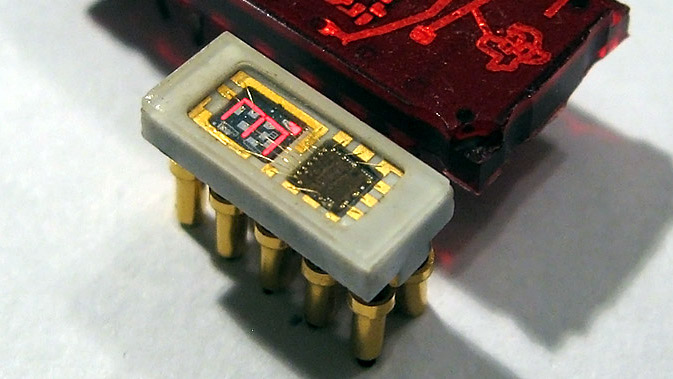
The 490IP1 is called an intelligent LED display because the package contains a decade counter and driver circuitry for the integrated seven-segment LED digit, complete with a carry signal that meant multiple displays could be chained together. It is notable not just due to its size, but because the glass cover makes it easy to see the die inside, as well as the wire-bonded pads.
It’s always fascinating to see glimpses of the development path that display technologies took. It’s easy to take a lot of it for granted today, but back before technology was where it is now, all sorts of things were tried. Examples we’ve seen in the past include the fantastic (and enormous) Eidophor projector which worked by drawing images onto a rotating disk of oil with an electron gun. On the smaller end of things, the Sphericular display used optics and image masks to wring a compact 0-9 numerical display out of only a few lamps at the back of a box.
















So what’s up with the large pins underneath? I feel this is a plugin module and the large pins made it easier to change and also were designed to ensure a good connection in harsh environments but….
I believe those “Large Pins” are actually the outside of sockets. Looks like those machined pin sockets removed from plastic.
The one that I have has normal legs. Proof:
https://flic.kr/p/ocSa5U
https://flic.kr/p/nVsz2a
Beautiful. Thanks for (more) photos!
You’re welcome. BTW, АЛС363А are probably even more exotic because they use IR leds and anti-stokes phosphor. I made a running line with them :
https://flic.kr/s/aHsjf9XZDb
They are terribly inefficient, but very magical.
Yahoo wanted me to get an account to see your link…
Nope!
@Ren I’ve just checked logged out in a different browser too and no, nothing is required to view my link.
@Ren: I can view the pictures with this link – https://www.flickr.com/photos/svofski/sets/72157617122516936/
With the supplied flic.kr link FiFo with noScript+noAds+etc delivers me to a yahoo login page too.
My opera without plugins works.
-> I guess the url-shortener doesn’t like script blockers…
[limroh], your link worked on my PC at work, which is strange, because “work” is more selective about external links…
is the red really that vibrant, or camera exposure?
I suspect early red LED was closer to IR than orange, so the camera may be enhancing it a bit
It’s very close to how it is. IRL it’s very red kind of red, oldskool leds were like that.
I think those are just pin sockets. In the photo it looks like the module is driven via hidden wires poking through the cardboard or paper from underneath and connected to the sockets.
This is what the killer app of home semiconductors will be